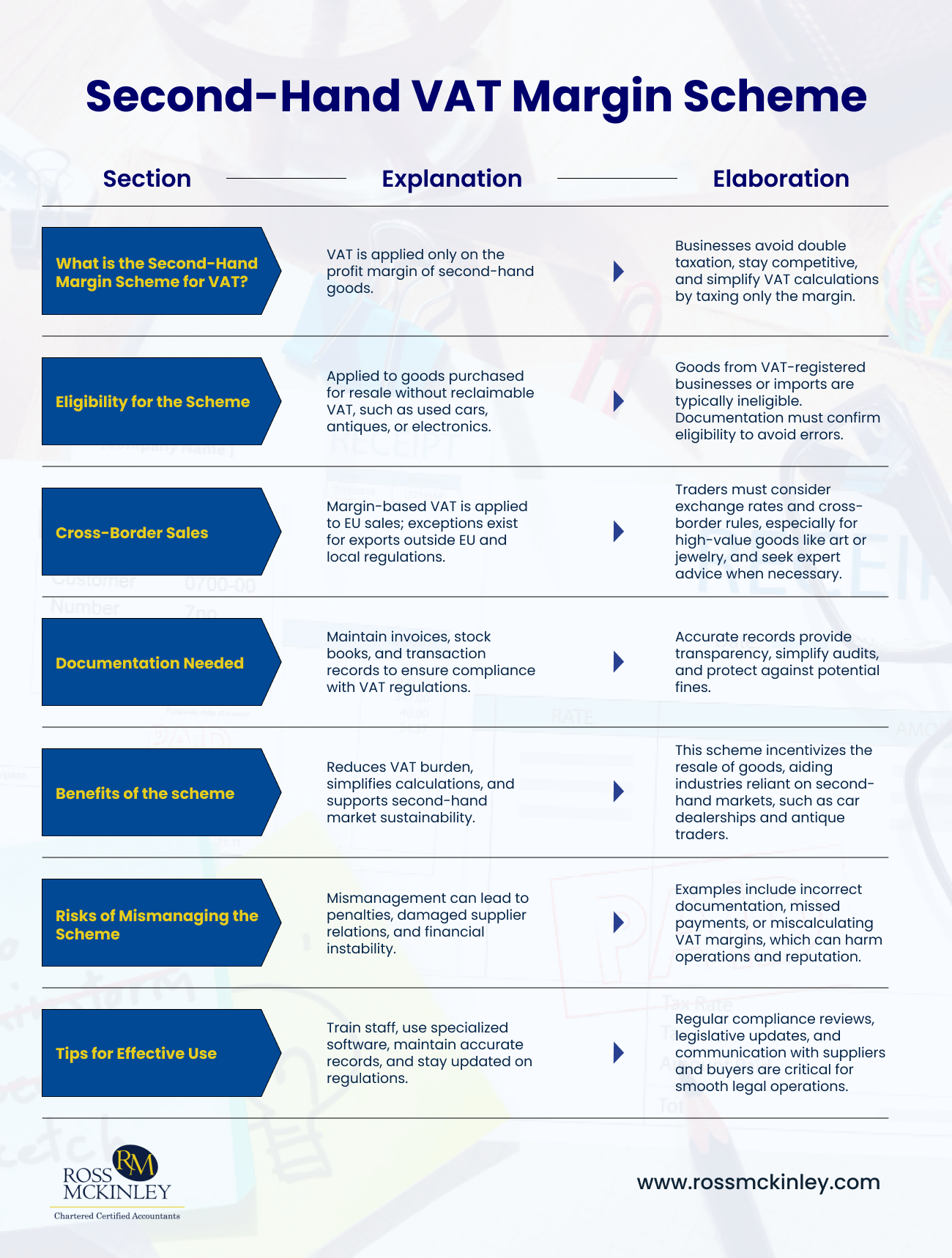Managing VAT can feel like walking through a maze, confusing and complex simultaneously. Do you need help to stay compliant while maintaining competitive pricing? The second-hand VAT margin scheme might be the solution your business needs.
This scheme reduces the VAT burden, allowing traders to focus on profit margins instead of the entire sale price. It’s a game-changer for industries like used car dealerships, antique shops, and second-hand electronics stores.
Ready to learn how to make this scheme work for you? This blog elaborates on how the second-hand VAT margin scheme works, eligibility criteria, cross-border sales, essential documentation, and expert tips for using it effectively.

Table of Contents
What Is the Second-Hand VAT Margin Scheme and How Does It Work?
The VAT margin scheme for second-hand goods allows businesses to pay VAT only on the profit margin of eligible second-hand goods. It benefits traders dealing with used items such as cars, electronics, or furniture.
For example, if a business purchases a second-hand car for £5,000 and sells it for £6,000, VAT is applied only to the £1,000 profit margin. The approach differs from traditional VAT schemes that tax the entire sale price.
Moreover, it also supports the sustainability of the second-hand market by incentivizing the resale of goods. The scheme benefits industries heavily reliant on second-hand goods, such as used car dealerships or antique traders, fostering growth and compliance.
Additionally, the second-hand margin scheme for VAT calculations is for traders, who only need to account for the margin rather than the full sale price. It not only reduces administrative burdens but also enhances financial transparency for both businesses and their customers.
| Section | Explanation | Elaboration |
| What is the Second-Hand Margin Scheme for VAT? | VAT is applied only on the profit margin of second-hand goods. | Businesses avoid double taxation, stay competitive, and simplify VAT calculations by taxing only the margin. |
| Eligibility for the Scheme | Applied to goods purchased for resale without reclaimable VAT, such as used cars, antiques, or electronics. | Goods from VAT-registered businesses or imports are typically ineligible. Documentation must confirm eligibility to avoid errors. |
| Cross-Border Sales | Margin-based VAT is applied to EU sales; exceptions exist for exports outside EU and local regulations. | Traders must consider exchange rates and cross-border rules, especially for high-value goods like art or jewelry, and seek expert advice when necessary. |
| Documentation Needed | Maintain invoices, stock books, and transaction records to ensure compliance with VAT regulations. | Accurate records provide transparency, simplify audits, and protect against potential fines. |
| Benefits of the scheme | Reduces VAT burden, simplifies calculations, and supports second-hand market sustainability. | This scheme incentivizes the resale of goods, aiding industries reliant on second-hand markets, such as car dealerships and antique traders. |
| Risks of Mismanaging the Scheme | Mismanagement can lead to penalties, damaged supplier relations, and financial instability. | Examples include incorrect documentation, missed payments, or miscalculating VAT margins, which can harm operations and reputation. |
| Tips for Effective Use | Train staff, use specialized software, maintain accurate records, and stay updated on regulations. | Regular compliance reviews, legislative updates, and communication with suppliers and buyers are critical for smooth legal operations. |
Eligible Acquisition of Second-Hand Goods
Only specific second-hand goods qualify under the second-hand VAT margin scheme. Items must be used and purchased for resale, and no VAT is reclaimable on their original purchase. Examples include pre-owned vehicles, antique furniture, and second-hand electronics bought from private individuals.
For example, the sale falls under the scheme if a business buys a vintage table from a private seller. However, if the same table is purchased from a VAT-registered business, it typically does not qualify because VAT was already applied to the original transaction.
Carefully determining the eligibility of goods ensures compliance and prevents errors when calculating VAT under this scheme. Businesses must verify the origin of their stock and confirm eligibility to avoid miscalculations.
Businesses should also document the source of their goods. If the origin is unclear, VAT authorities may disallow the scheme, leading to potential penalties.
Cross-Border Sales of Second-Hand Goods and Exception
The second-hand VAT margin scheme still applies when selling second-hand goods across borders. For example, a UK-based trader selling a used car to an EU buyer would calculate VAT based on the margin, provided the goods meet the scheme’s requirements. Thus, businesses engaging in international trade remain competitive by not overburdening their pricing with additional VAT.
However, exceptions exist. For example, sales involving goods exported outside the EU may not qualify for the scheme. Additionally, VAT regulations can vary across borders, and businesses must know specific rules in each country. For example, a second-hand watch exported to the US might require alternative VAT handling depending on local regulations.
Traders must also consider exchange rates and cross-border invoicing rules when calculating VAT on margins. Ensuring accuracy in these areas helps avoid discrepancies and maintains compliance with international VAT requirements.
Businesses should consult relevant VAT guidelines or seek expert advice to avoid penalties while handling cross-border sales effectively. It is particularly important to reclaim VAT on a second-hand margin scheme correctly when dealing with high-value second-hand goods like art, cars, or jewelry.
Documents Needed When Using a Second-Hand Margin Scheme
Proper documentation is vital when using the VAT on second-hand margin schemes. Businesses must maintain invoices showing the purchase and sale details, including the margin on which VAT is calculated. These records help verify compliance during audits and protect businesses from potential penalties.
Additionally, businesses should keep stock books or digital records detailing the item description, purchase price, selling price, and VAT margin. For example, a second-hand furniture dealer might record the purchase price of a sofa, its resale price, and the calculated VAT margin.
Accurate documentation ensures transparency and simplifies VAT reporting. Without proper records, businesses risk misreporting VAT, which can result in fines or other legal consequences. Therefore, investing in reliable accounting systems and ensuring detailed record-keeping practices are in place is essential.
Furthermore, having well-maintained records can give businesses insights into sales trends and profitability, helping them make informed decisions about inventory and pricing strategies.
Tips for Businesses Using the Scheme
Using the second-hand VAT margin scheme effectively requires careful planning and record-keeping. Below are some practical tips to streamline processes and ensure compliance.
Maintain Detailed Records of Purchases and Sales
Record all transactions accurately, including purchase and sale prices, to calculate VAT correctly. Organized records help avoid errors and provide a clear audit trail.
Use Specialized Accounting Software to Streamline Calculations
Adopt accounting software designed for VAT margin scheme calculations. These tools can simplify margin calculations and reduce the risk of mistakes when applying the scheme.
Train Staff to Understand the Scheme and Its Application
Educate employees on the scheme’s rules and proper documentation procedures. For example, sales staff should know how to issue invoices that comply with the scheme’s requirements.
Regularly Review Transactions to Ensure Compliance With Regulations
Conduct regular audits of your transactions to verify compliance with VAT regulations. Regular reviews help identify and correct discrepancies early, reducing the risk of penalties.
Conclusion
The second-hand VAT margin scheme is essential for businesses selling second-hand goods. It allows them to stay competitive while complying with VAT rules. Accurate record-keeping and understanding eligibility requirements are key to leveraging this scheme effectively.
Additionally, ensure you communicate clearly with suppliers and buyers about the VAT margin scheme’s application to avoid misunderstandings. Transparency can foster better relationships and improve operational efficiency. Consider seeking professional advice to stay updated on changing VAT regulations and their impact on your business.
Ross Mckinley provides expert support with the second-hand VAT margin scheme, helping you save money and stay compliant. As a trusted local chartered accountancy business, we make VAT simple and stress-free. Contact us today to see how we can help your business grow.

